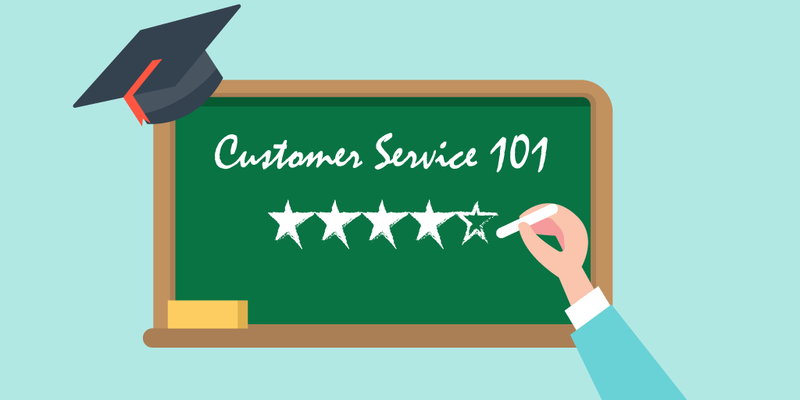It is something that we have all experienced and talked about with our friends, co-workers and family members. Even if we are fond of a product/service we get so frustrated by it that start searching for other substitutes… What is it? The answer is obvious – bad customer service!
Many businesses believe that they are customer-friendly. However, it often turns out not to be the case. Below, you can find a list of 8 lessons to improve customer service and guarantee that your customers talk only good things about your business, even behind your back.
Let’s start with our curriculum!
Chapter 1: Understanding the Customer
Recognizing your customer segments is one of the main parts of marketing, and the same goes for improving the customer service. Before building a positive relationship with your customer, you must know who they are.
But getting to know your customers goes beyond the idea of knowing their name. You must understand what their needs and wants are, what problems you are solving for them, and what motivates them to use your services and products.
Chapter 2: Knowing the Product
Customer service is all about problem-solving and assisting, but how can you be of help in those kinds of situations when an employee has limited knowledge of the product or service?
In the words of Bill Bernbach, “Know your product inside and out before you start working. And relate that knowledge to the consumer’s needs.”
Every time people interact with your product, they come up with different questions. It is important to have the answers readily available for them. Product knowledge displays your customer service staff as competent and confident.
Serving your customers with the information they are looking for and maybe also adding some additional valuable insights about the product will be a guarantee of advancing your business ahead of the competition.
Chapter 3: Clear Communication

Companies that want to improve their customer service need to communicate clearly with their clients. However, one must keep in mind that communication starts with good listening, and listening can be especially hard to master when it comes to customer service.
A well-known phrase is “the customer is always right”, but sometimes it happens so that customers are not right. It is important to make sure you listen carefully to your clients and figure out the core of the problem.
When we think about communication, we visualize talking with customers, but something that is often left ignored is non-verbal communication. In fact, over 90% of communication happens through body language and vocal tonality. That is why making sure that your employee’s voice and body demonstrate confidence is important as they represent your business.
You know what they say, "communication is the glue that keeps customer experiences from falling apart".
Chapter 4: Innovating
In order to provide superb customer service, the pen-and-paper method is not enough anymore. Businesses became very competitive and realize that investing money in innovating tools that can increase the customer satisfaction will result in higher profits and brand loyalty. Lagging behind your competitors is just that: losing an important race.
And that means scaring away your current and potential customers.
Innovations are a good way of showing that you keep up with the times. Even a cutting-edge queuing tool that helps better manage visitors can go a long way in encouraging customers to take your business more seriously.
Making sure that you implement innovation in the organization will give you a competitive advantage.
Chapter 5: Personalizing
Your customers are different from each other. Personalizing their experience when they use your business will result in more loyal clients that feel appreciated by your company and that feeling will create a strong bond which is fundamental for improving customer experience.
There are various ways of giving a personal touch. It can start with a smaller scale such as greeting your customers by name and smiling more as well as having a non-formal and friendly conversation with them.
However, it can also be taken to a bigger scale like predicting their needs and suggesting products that would be relevant to them with the help of technologies and customer data.
Chapter 6: Empathizing

Yes, we said that customer service is about problem-solving but this does not cover the whole story. Today having a human interaction is seen as very genuine. After showing your customer warmth they will feel like doing business with an actual person and not just a company.
The boom of social media resulted in lack of real human interaction between people. As soon as you show those attributes and empathize with your clients, you will win them over. Perfect customer service must feel human as it will show your customer that you really care about them.
Make sure your customer remembers you positively and carry this positivity every time they talk about your product or user it. You might not always solve your client's problem, but you can always make them feel important!
Chapter 7: Managing
We’ve all heard that one should spend more time with the customer for a better experience, but we also know that everything has its limits. In a situation where a fair number of customers are waiting to be served, efficiency becomes crucial. A great customer service employee should be managing the time with customers appropriately.
One of the ways of managing is triaging, which refers to the act of allocating customers according to different levels of priority in order that top-priority customers are being served first. This practice is important and commonly used in the healthcare sector.
You can easily manage the patient reception, manage the serving time and make sure that customers are served according to their priority issues with a help of the Qminder queue management system.
Final Chapter: Improving
We’ve come a long way to reach this point, but the truth is that this road has no end. Customer service is not static. The main concept of it is to keep improving through learned lessons and keeping up with the innovations.
Even though continuous improvement might seem like an easy and self-explanatory term, it might get complicated.You must understand that today there is more competition going on than ever, which is a good thing. This enables us to enhance and upgrade our product that will benefit the customer’s needs.
One of the main ways of improving your customer service is through learned lessons. And it is possible to learn your lessons through information. You can have this information from online, where your customers leave their certain purchasing behavior patterns or through innovative tools that give you insights about your consumer preferences and habits.
To make a long story short you have to understand that regardless of superb customer service your business is providing, there is always a room for improvement and in order to outperform your competitors you should continuously be searching for those improvement possibilities.






